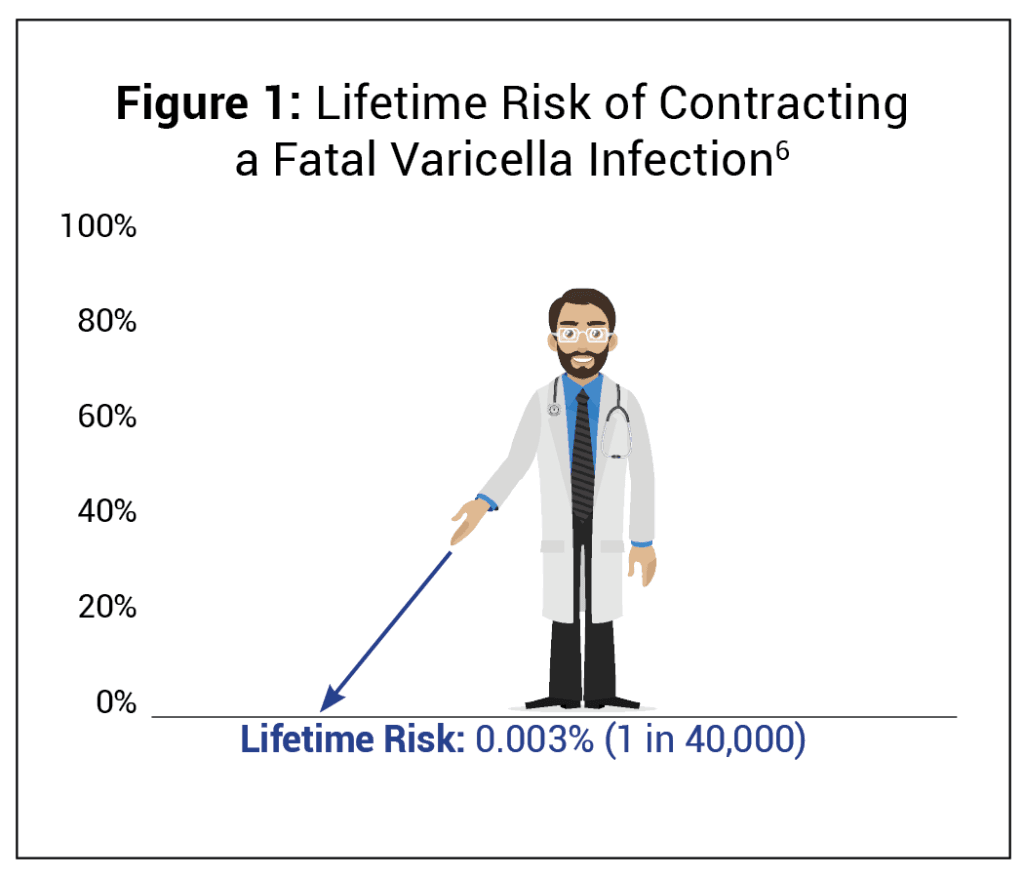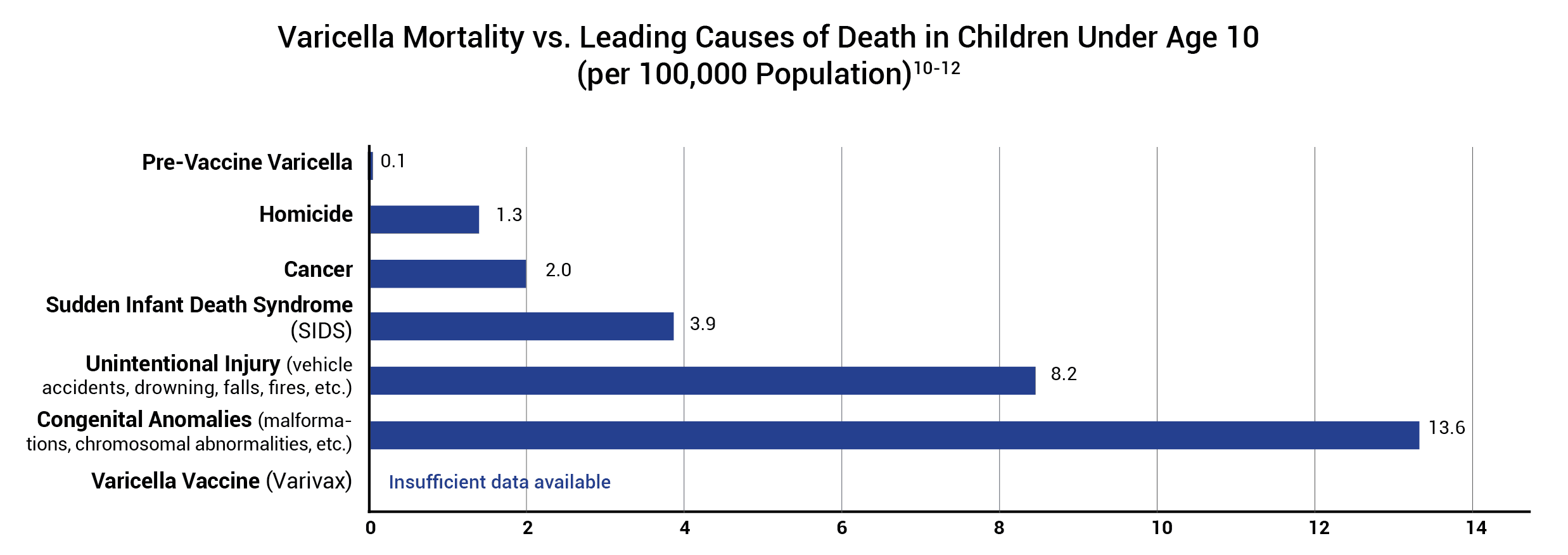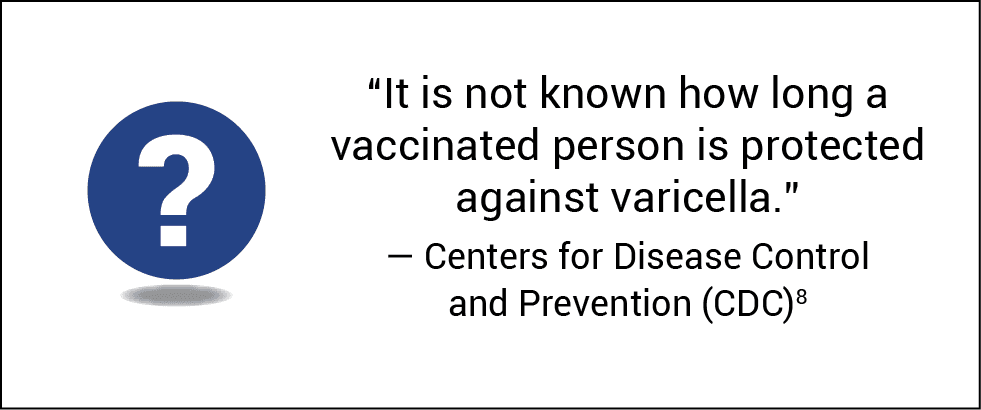Varicella (Chicken Pox): What You Need to Know
 1. WHAT IS VARICELLA?
1. WHAT IS VARICELLA?
Varicella is a viral infection.
- Varicella symptoms include fever and itching, which typically resolve after a few days.1 Symptoms also include a skin rash throughout the body that takes about a week to develop into scabs.2
- Most new varicella infections are benign and not reported to public health departments.3
- Before the varicella mass vaccination program was introduced, most of the population contracted varicella and obtained lifetime immunity by adolescence.4
- In rare situations, varicella can be fatal. Most fatal cases of varicella occur in adults age 20 or older.5

- More than 96% of infections are benign3
- Fever and itching typically resolve in 2–4 days1
- Before the vaccine, about 90% of the population obtained lifetime immunity by age 154

- More than 96% of infections are benign3
- Fever and itching typically resolve in 2-4 days1
- Before the vaccine, about 90% of the population obtained lifetime immunity by age 154
 2. WHAT ARE THE RISKS?
2. WHAT ARE THE RISKS?
Fatal cases of varicella are rare in the United States. Before the introduction of the varicella vaccination program, 1 in 40,000 or 0.003% of varicella cases were fatal (Fig. 1).6 In addition, about 3 in 1,000 or 0.3% of varicella cases were hospitalized.6
For some people, varicella virus can remain in their body after they recover from chicken pox, and the virus can reactivate later in life and cause shingles. However, severe complications or death from shingles is very rare.7

3. WHAT TREATMENTS ARE AVAILABLE?
Because varicella resolves on its own in almost all cases, usually only rest and hydration are necessary. Immune globulin is also available for immunocompromised patients who are exposed to chicken pox, such as those on chemotherapy.4

![]()
4. WHAT ABOUT THE VARICELLA VACCINE?
The varicella vaccine was introduced in the U.S. in 1995. It has significantly reduced the incidence of reported (i.e., noticeable) cases of varicella infections; however, the Centers for Disease Control and Prevention (CDC) states, “It is not known how long a vaccinated person is protected against varicella,” and, “Several studies have shown that people vaccinated against varicella had antibodies for at least 10 to 20 years after vaccination. But, these studies were done before the vaccine was widely used and when infection with wild-type varicella was still very common.”8 In other words, it’s possible that the antibody counts observed in vaccinated populations were affected by exposure to wild-type varicella.
The manufacturer’s package insert contains information about vaccine ingredients, adverse reactions, and vaccine evaluations. For example, “Varivax Refrigerated has not been evaluated for its carcinogenic or mutagenic potential, or its potential to impair fertility.”9 Furthermore, the risk of permanent injury or death from the varicella vaccine has not been proven to be less than that of varicella (Fig. 2).10

Figure 2: This graph shows the varicella mortality rate before the vaccine was introduced and compares it to the leading causes of death in children under age 10 today. Hence, in the pre-vaccine era, the varicella mortality rate per 100,000 was 0.1 for children under age 10. In 2015, the mortality rate per 100,000 for homicide was 1.3, followed by cancer (2.0), SIDS (3.9), unintentional injury (8.2), and congenital anomalies (13.6). The rate of death or permanent injury from the varicella vaccine is unknown because the research studies available are not able to measure it with sufficient accuracy.
REFERENCES
- Centers for Disease Control and Prevention. Epidemiology and prevention of vaccine-preventable diseases. 14th ed. Hall E, Wodi AP, Hamborsky J, Morelli V, Schillie S, editors. Washington, D.C.: Public Health Foundation; 2021. 330. https://physiciansforinformedconsent.org/cdc-pink-book-14th-edition-2021/.
- Centers for Disease Control and Prevention. Washington, D.C.: U.S. Department of Health and Human Services. Chickenpox (varicella): chickenpox symptoms and complications. 2024 May 10 [cited 2025 Jan 22]. https://physiciansforinformedconsent.org/cdc-chickenpox-signs-symptoms.
- Centers for Disease Control and Prevention. Epidemiology and prevention of vaccine-preventable diseases. 13th ed. Hamborsky J, Kroger A, Wolfe S, editors. Washington, D.C.: Public Health Foundation; 2015. 359, Appendix E5. https://physiciansforinformedconsent.org/cdc-pink-book-13th-edition-and-appendix-e-2015-combo; in the early 1990s, annually there were about 4 million cases, of which about 150,000 (3.75%) were reported.
- Centers for Disease Control and Prevention. Epidemiology and prevention of vaccine-preventable diseases. 13th ed. Hamborsky J, Kroger A, Wolfe S, editors. Washington, D.C.: Public Health Foundation; 2015. 359, 374. https://physiciansforinformedconsent.org/cdc-pink-book-13th-edition-2015/.
- Meyer PA, Seward JF, Jumaan AO, Wharton M. Varicella mortality: trends before vaccine licensure in the United States, 1970–1994. J Infect Dis. 2000 Aug;182(2):383-90. https://pubmed.ncbi.nlm.nih.gov/10915066/.
- Centers for Disease Control and Prevention. Epidemiology and prevention of vaccine-preventable diseases. 13th ed. Hamborsky J, Kroger A, Wolfe S, editors. Washington, D.C.: Public Health Foundation; 2015. 356, 359. https://physiciansforinformedconsent.org/cdc-pink-book-13th-edition-2015/; in the early 1990s, annually there were about 4 million cases, of which about 11,000 (0.3%) resulted in hospitalization and 103 (0.003%) were fatal.
- Centers for Disease Control and Prevention. Washington, D.C.: U.S. Department of Health and Human Services. Zoster (shingles) vaccine: addressing common questions about shingles vaccination for adults; updated 2016 May [cited 2023 Nov 3]. https://physiciansforinformedconsent.org/cdc-zoster-shingles-vaccine-addressing-common-questions-about-shingles-vaccination/.
- Centers for Disease Control and Prevention. Washington, D.C.: U.S. Department of Health and Human Services. About the varicella vaccines; [cited 2023 April 7]. https://www.cdc.gov/vaccines/vpd/varicella/hcp/about-vaccine.html.
- Merck Sharp & Dohme, Corp. Whitehouse Station (NJ): Merck & Co, Inc. Varivax Refrigerated: Varicella Virus Vaccine Live (Oka/Merck); 2016 Sep 02. 8. https://physiciansforinformedconsent.org/merck-varivax-refrigerated-varicella-virus-vaccine-live.
- Physicians for Informed Consent. Newport Beach (CA): Physicians for Informed Consent. Varicella (chicken pox) – vaccine risk statement (VRS). Varicella vaccine: is it safer than varicella (chicken pox)? 2023 Sep; updated 2023 Nov. physiciansforinformedconsent.org/varicella-vrs.
- Meyer PA, Seward JF, Jumaan AO, Wharton M. Varicella mortality: trends before vaccine licensure in the United States, 1970–1994. J Infect Dis. 2000 Aug;182(2):383-90. https://pubmed.ncbi.nlm.nih.gov/10915066/; in the early 1990s, annually there were about 38 fatal cases of varicella under age 10 out of a population of about 40 million children (0.1 per 100,000 children under age 10).
- Centers for Disease Control and Prevention. Washington, D.C.: U.S. Department of Health and Human Services. 10 leading causes of death by age group, United States—2015. https://physiciansforinformedconsent.org/cdc-leading-causes-of-death-age-group-2015/.
Published 2023 Sep; updated 2025 Feb


